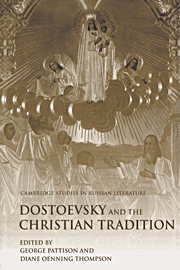Book contents
- Frontmatter
- Contents
- Notes on contributors
- Acknowledgments
- Notes on conventions and abbreviations
- Introduction: Reading Dostoevsky religiously
- PART I DOSTOEVSKY AND THE PRACTICE OF ORTHODOXY
- PART II DOSTOEVSKY AND CHRISTIAN THEOLOGY
- PART III READING DOSTOEVSKY RELIGIOUSLY: CASE STUDIES
- 9 Towards an iconography of Crime and Punishment
- 10 Pavel Smerdyakov and Ivan Karamazov: The problem of temptation
- 11 Beyond the will: Humiliation as Christian necessity in Crime and Punishment
- 12 Freedom's dangerous dialogue: reading Dostoevsky and Kierkegaard together
- Bibliography
- Index
- CAMBRIDGE STUDIES IN RUSSIAN LITERATURE
9 - Towards an iconography of Crime and Punishment
Published online by Cambridge University Press: 02 December 2009
- Frontmatter
- Contents
- Notes on contributors
- Acknowledgments
- Notes on conventions and abbreviations
- Introduction: Reading Dostoevsky religiously
- PART I DOSTOEVSKY AND THE PRACTICE OF ORTHODOXY
- PART II DOSTOEVSKY AND CHRISTIAN THEOLOGY
- PART III READING DOSTOEVSKY RELIGIOUSLY: CASE STUDIES
- 9 Towards an iconography of Crime and Punishment
- 10 Pavel Smerdyakov and Ivan Karamazov: The problem of temptation
- 11 Beyond the will: Humiliation as Christian necessity in Crime and Punishment
- 12 Freedom's dangerous dialogue: reading Dostoevsky and Kierkegaard together
- Bibliography
- Index
- CAMBRIDGE STUDIES IN RUSSIAN LITERATURE
Summary
I take as my starting point the first of several dreams depicted by Dostoevsky in his novel Crime and Punishment (1866). It is made to occur shortly before the protagonist, Raskolnikov, carries out his crime and, like the dreams which occur after the murder, is charged with violence. In his dream, Raskolnikov recalls the scene of his provincial childhood. He is on his way with his father to visit the grave of his grandmother and of his baby brother. But in the dream the progress of father and son is arrested by a violent incident which occurs outside the tavern on the road to the church. A crowd of drunken peasants has been invited to get on a huge cart to which a mare has been harnessed; but it is incapable of pulling such a load. Infuriated by this, the intoxicated owner, goaded on by the other peasants, proceeds to beat the horse to death. The boy tries to stop the onslaught himself, but his father pulls him away from the crowd saying: ‘It's not our business. Come along!’ The boy appeals to his father, but the father merely responds with: ‘Come along, son, come along! <…> let's go home <…> They're drunk’ (75). The dream narrative ends: ‘He put his arms round his father <…> He tried to draw a breath, to cry out and – woke up’ (78).
- Type
- Chapter
- Information
- Dostoevsky and the Christian Tradition , pp. 173 - 188Publisher: Cambridge University PressPrint publication year: 2001



